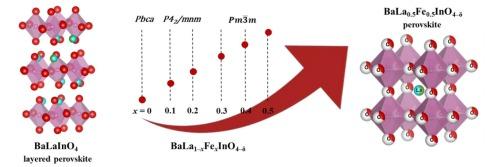新型三导电层状钙钛矿BaLa1-xFexInO4 -δ
IF 4.6
3区 材料科学
Q2 MATERIALS SCIENCE, MULTIDISCIPLINARY
引用次数: 0
摘要
本文获得并研究了新型三导电层状钙钛矿BaLa1-xFexInO4 -δ作为电化学器件的潜在材料。结果表明,在镧亚晶格中加入铁元素可以提高晶格的对称性。铁以两种氧化态Fe2+和Fe3+存在。得到的BaLa0.9Fe0.1InO4 -δ样品呈水化反应。掺杂剂浓度的增长导致电导率的显著增长(高达4个数量级)。掺入少量杂质的BaLa0.9Fe0.1InO4 -δ样品在干燥空气中具有混合氧/离子/空穴电导率,在潮湿空气中具有三重质子/氧离子/空穴电导率。x = 0.4的样本;0.5主要是孔电导率。Ba1.1La0.9InO3.95和BaLa0.9Fe0.1InO4 -δ具有相近的热膨胀系数。本文章由计算机程序翻译,如有差异,请以英文原文为准。

Novel triple conducting layered perovskites BaLa1–xFexInO4–δ
In this paper, novel triple conducting layered perovskites BaLa1–xFexInO4–δ as potential materials for electrochemical devices have been obtained and investigated. It is elucidated that an iron addition into the lanthanum sublattice increases the crystalline lattice symmetry. Iron is present in two oxidation states Fe2+ and Fe3+. The obtained BaLa0.9Fe0.1InO4–δ sample was found to hydrate. The dopant concentration growth resulted in the significant growth of the electrical conductivity (up to ∼ 4 orders of magnitude). The BaLa0.9Fe0.1InO4–δ sample with a small dopant concentration is characterized by a mixed oxygen/ion/hole conductivity in dry air and by a triple protonic/oxygen-ionic/hole conductivity in humid air. The samples with x = 0.4; 0.5 have predominantly hole conductivities. The Ba1.1La0.9InO3.95 and BaLa0.9Fe0.1InO4–δ have similar values of the thermal expansion coefficients.
求助全文
通过发布文献求助,成功后即可免费获取论文全文。
去求助
来源期刊

Materials Science and Engineering: B
工程技术-材料科学:综合
CiteScore
5.60
自引率
2.80%
发文量
481
审稿时长
3.5 months
期刊介绍:
The journal provides an international medium for the publication of theoretical and experimental studies and reviews related to the electronic, electrochemical, ionic, magnetic, optical, and biosensing properties of solid state materials in bulk, thin film and particulate forms. Papers dealing with synthesis, processing, characterization, structure, physical properties and computational aspects of nano-crystalline, crystalline, amorphous and glassy forms of ceramics, semiconductors, layered insertion compounds, low-dimensional compounds and systems, fast-ion conductors, polymers and dielectrics are viewed as suitable for publication. Articles focused on nano-structured aspects of these advanced solid-state materials will also be considered suitable.
 求助内容:
求助内容: 应助结果提醒方式:
应助结果提醒方式:


